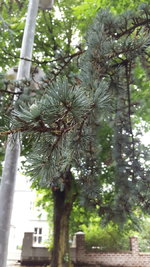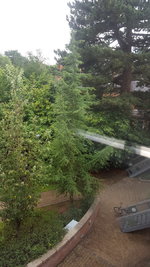@bonsai-novice
There are several species of kiwi-fruit, Actinidia is the genus name. The most common is the "standard kiwi" Actinidia deliciosa, it is only hardy to warmer half of zone 7. The "golden Kiwi" is Actinidia chinensis, which is more popular as a culinary fruit in China, where as in EU and USA Actinidia deliciosa is more common in the grocery stores. Actinidia chinensis is winter hardy through USDA zone 7 into USDA zone 6. There are a couple other culinary fruit species, Actinidia coriacea, melanandra, and purpurea, but they are not as common in the grocery stores. All are zone hardy only through zone 7.
Hardy kiwifruit are the species Actinidia arguta (all of zone 5) and Actinidia kolomikta (thru all of zone 4). Both of these have small grape size fruit. A. kolomikta fruit is smaller than grape size. The fruit is edible, though it takes a big vine to grow more than a mouthful.
I've never seen the plants of the culinary kiwis, I would assume that the comments by
@Shibui are correct. When you prune just leave a long stub, and then go back months later and prune away the dried and dead parts. The vine will keep growing. All members of Actinidia are dioecious, meaning an entire plant from seed is either male or female. In order to get fruit you must have one of each, and they should be planted within about 10 feet or 3 meters of each other. Too far apart and pollination drops as bugs (not just bees) are less efficient at getting from the male to the female flowers. In commercial fruit orchards, 3 to 5 females are planted in a row, then a male, then another 3 to 5 females, then a male. The adjacent row, usually 10 foot away, they stagger the start of the pattern so that across the row from the females are the male in the pattern. They are planted in orchards very similar to the way grapes are planted in a vineyard.
I have seen, touched even, my friend Irene's Actinidia arguta. She has a fairly old, maybe 10 year old vine growing in the ground, in Wisconsin (
@HorseloverFat ). The vines have a nice rough bark that begins to develop maybe the 4th year. Flowers in middle of spring are very sweet smelling. With 10 years of age the vine is only a little larger in diameter than my thumb. The vine rambles up and out about 10 feet in all directions. The wood and bark do not seem to be as soft as
@Shibui describes for Actinidia deliciosa, as the Actinidia arguta has to be sturdy enough to survive Wisconsin winters. Wood seems more like grape in terms of hardness. (which is still not considered hardwood, especially wood less than 5 years old).
Like grape they could make a nice bonsai, and like grape many of the same issues are a problem. It takes many years to develop a "trunk". Generally you'll have to settle for thumb diameter trunks, unless you can find an old established vine in the landscape to harvest for bonsai. (not likely, except in New Zealand where it is a commercial crop).
I think Actinidia might be fun for those with room for a backyard vineyard to grow for the fruit. The less common species being the ones worth growing for fruit as the "standard" kiwi is too cheap to be worth the effort to grow for fruit at home. The species like A. coriacea, melanandra, and purpurea all have red or purple fruit with slightly different flavors for those in mild, zone 7 or warmer climates. Actinidia arguta is quite tasty, much like the standard kiwi, maybe a little sweeter, and would be fun to grow for those in zones 6 and 5.
In the landscape they need full sun, or at least a half day of direct sun, to bear fruit. They would not be a good choice for indoor growing. The large leaves and slowness to trunk up also mean they would be a less than ideal choice for "indoor bonsai" even if you had a high tech under lights set up. Actinidia is an outdoor plant.



